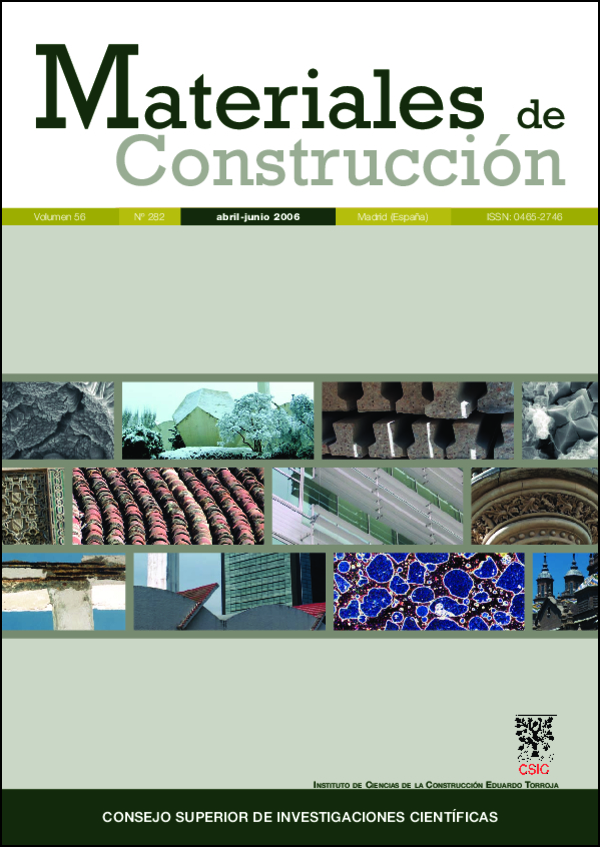Effect of sewage sludge ash (SSA) on the mechanical performance and corrosion levels of reinforced Portland cement mortars
DOI:
https://doi.org/10.3989/mc.2006.v56.i282.25Keywords:
waste recycling, pozzolan, mechanical strength, corrosion, durabilityAbstract
The article describes a study conducted to determinecorrosion in reinforcement embedded in Portland cement(PC) mortars with different percentages of sewage sludgeash (SSA) admixtures. The polarization resistancetechnique was used to determine the steel corrosion rate(Icorr) in the test specimens. The samples were subjectedto different environmental conditions and aggressiveagents: 100% relative humidity (RH), accelerated carbonationat 70% RH and seawater immersion. Portlandcement was partially substituted for SSA in the mixes atrates of 0, 10, 20, 30 and 60% (by mass) to make thedifferent mortars. The results show that where cementwas replaced by SSA at rates of up to 10% by mass,mortar corrosion performance was comparable to thebehaviour observed in SSA-free mortars (control mortar:0% SSA). Data for higher rates are also shown. From themechanical standpoint, SSA exhibited moderate pozzolanicactivity and the best performance when SSA wasadded at a rate of 10% to mixes with a water/(binder:PC + SSA) (w/b) ratio of 0.5.
Downloads
References
(1) Anderson, M., Skerratt, R. G., Thomas, J. P., Clay, S. D.: “Case study involving using fluidised bed incinerator sludge ash as a partial clay substitute in brick manufacture”, Water Science Technology, vol. 34 (1996), pp. 507-515. doi:10.1016/0273-1223(96)00618-X
(2) Wiebusch, B. Seyfried, C. F.: “Utilization of sewage sludge ashes in the brick and tile industry”, Water Science Technology, vol. 36 (1997), pp. 251-258. doi:10.1016/S0273-1223(97)00688-4
(3) Lin, D. F., Weng, C. H.: “Use of sewage sludge ash as brick material”, Journal of Environmental Engineering ASCE, vol. 127 (2001), pp. 922-927. doi:10.1061/(ASCE)0733-9372(2001)127:10(922)
(4) Bhatty, J. I., Reid, K. J.: “Compressive Strength of Municipal Sludge Ash Mortars”, ACI Materials Journal (1989), pp. 394-400.
(5) Wainwright, P., Cresswell, D.: “Synthetic aggregates from combustion ashes using an innovative rotary kiln”, Waste Management, vol. 21 (2001), pp. 241-246. doi:10.1016/S0956-053X(00)00096-9
PMid:11280515
(6) Al Sayed, M. H., Madany, I. M.; Buali, A. R. M.: “Use of Sewage Sludge Ash in Asphaltic Paving Mixes in Hot Regions”, Construction and Building Materials, vol. 9 (1995), pp. 19-23. doi:10.1016/0950-0618(95)92856-C
(7) Tay, J.: “Properties of Pulverized Sludge Ash Blended Cement”, ACI Materials Journal (1987), pp. 358-364.
(8) Pinarli, V.: “Sustainable Waste Management - Studies on the use of sewage sludge ash in the construction industry as concrete material”, en R. K. Dhir, T. D. Dyer, K. A. Paine, Thomas Telford (eds.): Proceedings Sustainable Construction. Use of incinerator ash, London, 2000, pp. 415-425.
(9) Monzo, J., Paya, J., Borrachero, M. V., Corcoles, A.: “Use of Sewage Sludge Ash (SSA)-Cement Admixtures in Mortars”, Cem. Concr. Res., vol. 26 (1996), pp. 1389-1398. doi:10.1016/0008-8846(96)00119-6
(10) Monzo, J., Paya, J., Borrachero, M. V., Peris-Mora, E.: “Mechanical Behavior of Mortars Containing Sewage Sludge Ash (SSA) and Portland Cement with Different Tricalcium Aluminate Content”, Cem. Concr. Res., vol. 29 (1999), pp. 87-94. doi:10.1016/S0008-8846(98)00177-X
(11) Monzo, J., Paya, J., Borrachero, M. V., Corcoles, A.: “Reuse of sewage sludge ashes (SSA) in cement mixtures: The effect of SSA on the workability of cement mortars”, Waste Management, vol. 23 (2003), pp. 373-381.
(12) Monzo, J., Paya, J., Borrachero, M. V., Bellver, A., Peris-Mora, E.: “Study of Cement-Based Mortars Containing Spanish Ground Sewage Sludge Ash”, en J. J. J. M. Goumans, G. J. Senden, H. A. Van der Sloot (eds.), Proceedings of WASCON´97 Waste Materials in Construction: Putting theory into practice. Elsevier, Amsterdam, 1997, pp. 349-354.
(13) Pan, S. C., Tseng, D. H.: “Sewage sludge ash characteristics and its potential applications”, Water Science and Technology, vol. 44 (2001), pp. 261-267.
(14) UNE-EN-196-1. Metodos de ensayos de cementos. Parte 1: Determinacion de resistencias mecanicas.
(15) Stern, M., Geary, A. L.: “A theorical analysis of the shape of polarization curves”, Journal Elec., vol. 104, no 1 (1957), p. 56.
(16) Stern, M., Weisert, E. D.: “Experimental observations on the relation between polarization resistance and corrosion rate”, Proc. Am. Soc. Test. Mater., vol. 59 (1959), p. 1280.
(17) Monzo, J., Paya, J., Borrachero, M. V.: “Experimental basic aspects for reusing sewage sludge ash (SSA) in concrete production”, en R. K. Dhir y T. G. Jappy (eds.): Exploiting Wastes in Concrete, Thomas Telford, London, 1999, pp. 47-56.
(18) Andrade, C., Gonzalez, J. A.: “Techniques electrochimiques qualitatives et quantitatives pour mesurer les effects des additions sur la corrosion des armatures”, Silicates Industriales, vol. 47 (1982), pp. 289-295.
Downloads
Published
How to Cite
Issue
Section
License
Copyright (c) 2006 Consejo Superior de Investigaciones Científicas (CSIC)

This work is licensed under a Creative Commons Attribution 4.0 International License.
© CSIC. Manuscripts published in both the print and online versions of this journal are the property of the Consejo Superior de Investigaciones Científicas, and quoting this source is a requirement for any partial or full reproduction.
All contents of this electronic edition, except where otherwise noted, are distributed under a Creative Commons Attribution 4.0 International (CC BY 4.0) licence. You may read the basic information and the legal text of the licence. The indication of the CC BY 4.0 licence must be expressly stated in this way when necessary.
Self-archiving in repositories, personal webpages or similar, of any version other than the final version of the work produced by the publisher, is not allowed.
















